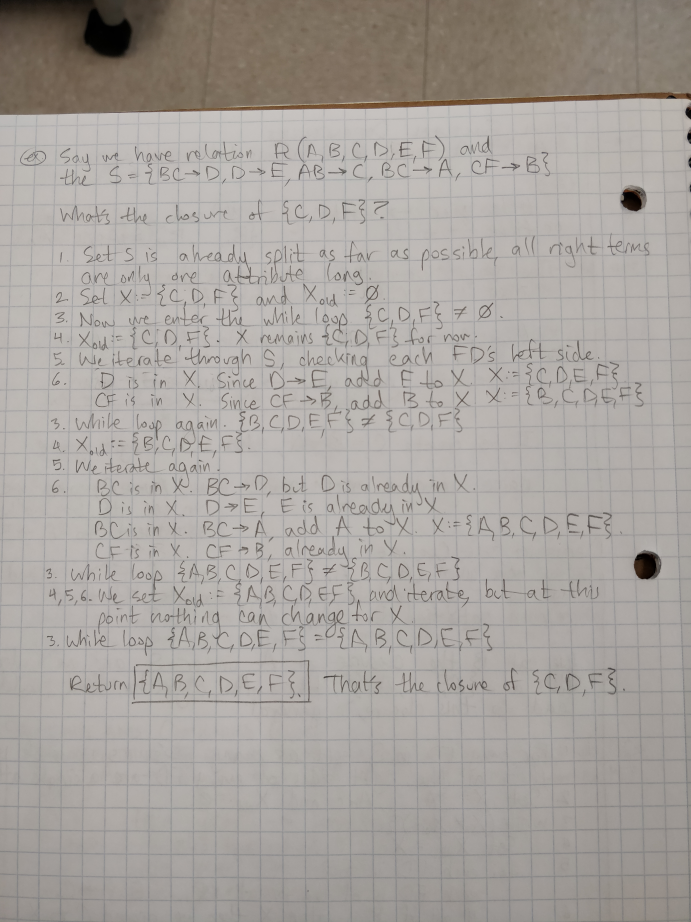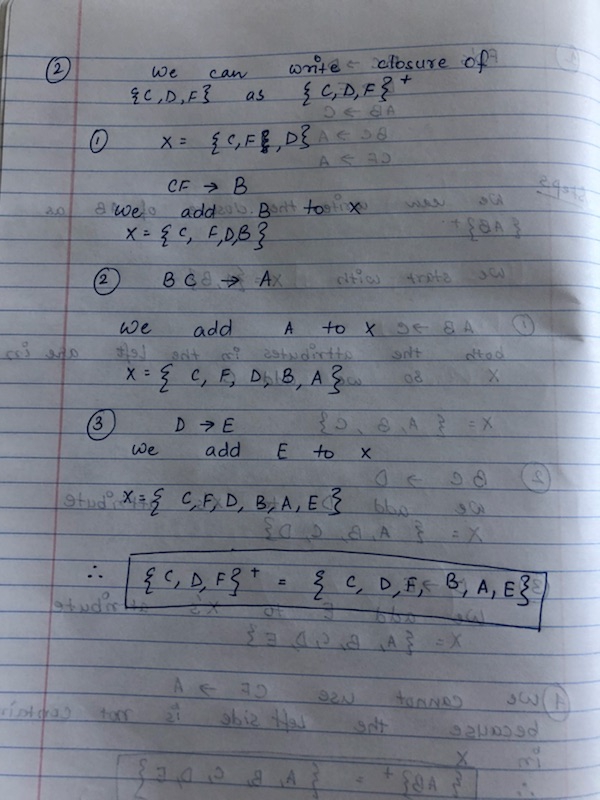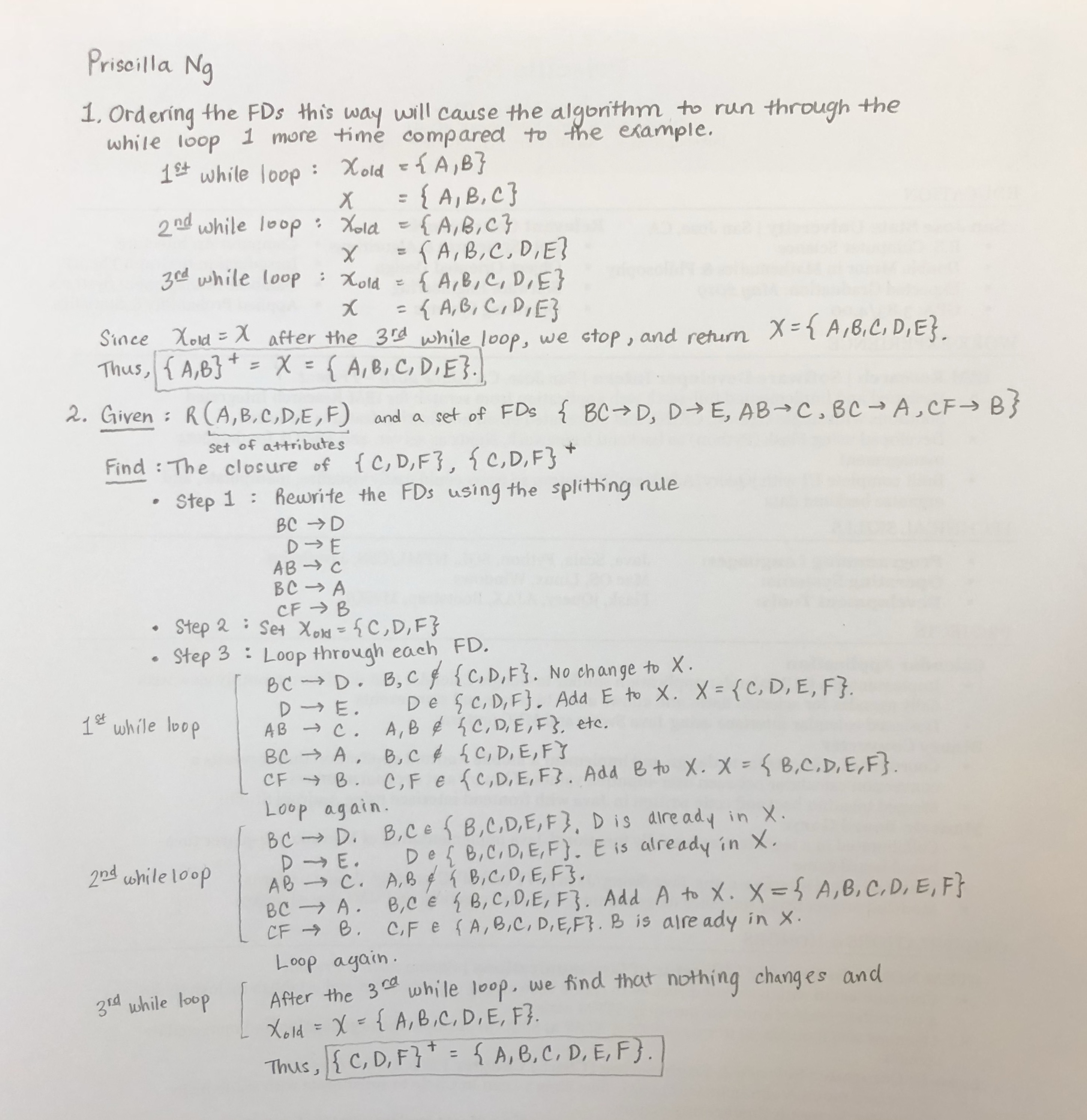2018-09-18
Sep 19 In-Class Exercise Thread.
Please post your solutions to the Sep 19 In-Class Exercise to this thread.
Chris
Please post your solutions to the Sep 19 In-Class Exercise to this thread.
Chris
2018-09-19
1. Since {A,B}≠∅ we execute the while loop at least once, and set Xold={A,B}.
first while loop:
step 1 would be BC→D, B,C ∈{A,B} are not valid so no changes
step 2 would be D→E, so no changes
step 3 would be AB→C, A,B∈{A,B} so we add C to X. X becomes X={A,B,C}
step 4 would be BC→A, so no changes
step 5 would be CF→B, so no changes
while loop second time:
step 6 would be BC→D, B,C ∈{A,B,C} are valid, so X becomes X={A,B,C,D}
step 7 would be D→E, so X becomes X={A,B,C,D,E}
it would take one more while loop
2.{C,D,F}
BC→D, no change
D→E, X becomes X={C,D,E,F}
AB→C, no change
BC→A, no change
CF→B, X becomes X={B,C,D,E,F}
BC→D, no change
D→E, no change
AB→C, no change
BC→A, X becomes X={A,B,C,D,E,F}
(Edited: 2018-09-19) 1. Since {A,B}≠∅ we execute the while loop at least once, and set Xold={A,B}.
first while loop:
step 1 would be BC→D, B,C ∈{A,B} are not valid so no changes
step 2 would be D→E, so no changes
step 3 would be AB→C, A,B∈{A,B} so we add C to X. X becomes X={A,B,C}
step 4 would be BC→A, so no changes
step 5 would be CF→B, so no changes
while loop second time:
step 6 would be BC→D, B,C ∈{A,B,C} are valid, so X becomes X={A,B,C,D}
step 7 would be D→E, so X becomes X={A,B,C,D,E}
it would take one more while loop
2.{C,D,F}
BC→D, no change
D→E, X becomes X={C,D,E,F}
AB→C, no change
BC→A, no change
CF→B, X becomes X={B,C,D,E,F}
BC→D, no change
D→E, no change
AB→C, no change
BC→A, X becomes X={A,B,C,D,E,F}
Student Name: Alexander Duong
1. Since the order is different, this causes the algorithm to go through the while loop one more time.
2.
1. X={C,D,F}
2. Skip BC->D since B is not in X.
3. X={C,D,E,F} since D->E and D is in X.
5. Skip AB->C since B is not in X.
6. Skip BC->A since B is not in X.
7. X={B,C,D,E,F} since CF-> B and CF is in X
8. Go through while loop again.
9. Skip BC->D since BC is already in X.
10. Skip AB->C since A is not in X
11. X={A,B,C,D,E,F} since BC->A and BC is already in X.
12. Go through while loop again.
13. Nothing is changed.
Therefore the output value of {C,D,F} is {A,B,C,D,E,F}
(Edited: 2018-09-19) Student Name: Alexander Duong
<nowiki>
1. Since the order is different, this causes the algorithm to go through the while loop one more time.
2.
1. X={C,D,F}
2. Skip BC->D since B is not in X.
3. X={C,D,E,F} since D->E and D is in X.
5. Skip AB->C since B is not in X.
6. Skip BC->A since B is not in X.
7. X={B,C,D,E,F} since CF-> B and CF is in X
8. Go through while loop again.
9. Skip BC->D since BC is already in X.
10. Skip AB->C since A is not in X
11. X={A,B,C,D,E,F} since BC->A and BC is already in X.
12. Go through while loop again.
13. Nothing is changed.
Therefore the output value of {C,D,F} is {A,B,C,D,E,F}
</nowiki>
{A, B} =x.old
We run through all of the FDs to obtain {A,B,C}
{A, B, C} =x.old
{A,B,C,D} - >{A, B, C, D, E}
{A, B, C, D, E} =x.old
Nothing changes so the while loop is finished executing.
{C, D, F} = x.old
{C,D,F,E} - > {C,D,F,E,B}
{C, D, F, E, B} = x.old
{C,D,F,E,B} - > {C, D, F, E, B, A}
{C,D,F,E,B,A} =x.old
Nothing is added, so the while loop terminates.
{A, B} =x.old
We run through all of the FDs to obtain {A,B,C}
{A, B, C} =x.old
{A,B,C,D} - >{A, B, C, D, E}
{A, B, C, D, E} =x.old
Nothing changes so the while loop is finished executing.
{C, D, F} = x.old
{C,D,F,E} - > {C,D,F,E,B}
{C, D, F, E, B} = x.old
{C,D,F,E,B} - > {C, D, F, E, B, A}
{C,D,F,E,B,A} =x.old
Nothing is added, so the while loop terminates.
1. first run the loop once set X = {A,B};
step 2:then BC-> D, BC not in X;
step 3: D->E, D not in X;
step 4: AB ->C => X = {A,B,C};
step 5: BC -> A, A in X already;
step 6: CF->B, B in X already;
step 7: BC-> D=> X ={A,B,C,D}
step 8: D->E => X ={A,B,C,D,E};
step 9: AB->C no change;
step 10: BC -> A no change;
step 11: CD -> B no change;
step 12: run the loop one more time without any change;
there are 7 more steps.
2:first foe each get X = {C,D,F}; AB->C no change; BC - > A no change; D-> E => X ={C,D,F,E}; CF -> B => X ={C,D,F,E,B}; Second time run the while loop: AB->C no change; BC-> A => X = {A,B,C,D,E,F}; D-> E and CF -> B no change; run the for each one more time without any change; return X
1. first run the loop once set X = {A,B};
step 2:then BC-> D, BC not in X;
step 3: D->E, D not in X;
step 4: AB ->C => X = {A,B,C};
step 5: BC -> A, A in X already;
step 6: CF->B, B in X already;
step 7: BC-> D=> X ={A,B,C,D}
step 8: D->E => X ={A,B,C,D,E};
step 9: AB->C no change;
step 10: BC -> A no change;
step 11: CD -> B no change;
step 12: run the loop one more time without any change;
there are 7 more steps.
2:first foe each get X = {C,D,F}; AB->C no change; BC - > A no change; D-> E => X ={C,D,F,E}; CF -> B => X ={C,D,F,E,B}; Second time run the while loop: AB->C no change; BC-> A => X = {A,B,C,D,E,F}; D-> E and CF -> B no change; run the for each one more time without any change; return X
1. BC -> D = no changes
2. D -> E = no changes
3. AB -> C = add C to X since A,B is an element of {A, B}
X = {A, B, C}
4. BC -> A = no changes
5. CF -> B = no changes
6. BC -> D = add D to X since B, C is an element of {A, B, C}
X = {A, B, C, D}
7. D -> E = add E
X = {A, B, C, D, E}
{C, D, F}
8. BC -> D = no changes
9. D -> E = E is added
X = {C, D, E, F}
10. AB -> C = no changes
11. BC -> A = no changes
12. CF -> B = B is added
X = {B, C, D, E, F}
13. BC -> D = no changes
14. D -> E = no changes
15. AB -> C = no changes
16. BC -> A = A is added
X = {A, B, C, D, E, F}
1. BC -> D = no changes
2. D -> E = no changes
3. AB -> C = add C to X since A,B is an element of {A, B}
X = {A, B, C}
4. BC -> A = no changes
5. CF -> B = no changes
6. BC -> D = add D to X since B, C is an element of {A, B, C}
X = {A, B, C, D}
7. D -> E = add E
X = {A, B, C, D, E}
{C, D, F}
8. BC -> D = no changes
9. D -> E = E is added
X = {C, D, E, F}
10. AB -> C = no changes
11. BC -> A = no changes
12. CF -> B = B is added
X = {B, C, D, E, F}
13. BC -> D = no changes
14. D -> E = no changes
15. AB -> C = no changes
16. BC -> A = A is added
X = {A, B, C, D, E, F}
1. Due to the different order in the FDs, the effect is that the while loop will run thrice this time instead of just twice like before.
After the first run of the while loop, X={A,B,C}.
After the second run of the while loop, X = {A,B,C,D,E}
And the third run does not change X.
Since the same set of FDs are used, albeit in a different order, hence the result of the closure of {A,B} will be the same, with X = {A,B,C,D,E}
2. Closure of {C,D,F} using FDs BC→D, D→E, AB→C, BC→A, and CF→B
Step 1: BC→D, D→E, AB→C, BC→A, and CF→B
Since {C,D,F}≠∅ execute while loop first time.
Set Xold={C,D,F}
Execute for each loop
first time: FD BC→D, B,C not∈{C,D,F}, no change to X.
second time: FD D→E, D∈{C,D,F}, add E to X, X = {C,D,E,F}
third time: FD AB→C, A,B not∈{C,D,E,F}, no change to X.
fourth time: FD BC→A, B,C not∈{C,D,E,F}, no change to X.
fifth time: FD CF→B, C,F∈{C,D,E,F}, add B to X, X = {B,C,D,E,F}
Since X={B,C,D,E,F} and Xold={C,D,F}, loop second time:
Set Xold={B,C,D,E,F}
Execute for each loop
first time: FD BC→D, no change to X.
second time: FD D→E, no change to X.
third time: FD AB→C, A,B not∈{B,C,D,E,F}, no change to X.
fourth time: FD BC→A, B,C∈{B,C,D,E,F}, add A to X. X = {A,B,C,D,E,F}
fifth time: FD CF→B, no change to X.
Since X={A,B,C,D,E,F} and Xold={B,C,D,E,F}, loop third time:
No change in X, so closure of {C,D,F} is X={A,B,C,D,E,F}
(Edited: 2018-09-19) 1. Due to the different order in the FDs, the effect is that the while loop will run thrice this time instead of just twice like before.
After the first run of the while loop, X={A,B,C}.
After the second run of the while loop, X = {A,B,C,D,E}
And the third run does not change X.
Since the same set of FDs are used, albeit in a different order, hence the result of the closure of {A,B} will be the same, with X = {A,B,C,D,E}
2. Closure of {C,D,F} using FDs BC→D, D→E, AB→C, BC→A, and CF→B
Step 1: BC→D, D→E, AB→C, BC→A, and CF→B
Since {C,D,F}≠∅ execute while loop first time.
Set Xold={C,D,F}
Execute for each loop
first time: FD BC→D, B,C not∈{C,D,F}, no change to X.
second time: FD D→E, D∈{C,D,F}, add E to X, X = {C,D,E,F}
third time: FD AB→C, A,B not∈{C,D,E,F}, no change to X.
fourth time: FD BC→A, B,C not∈{C,D,E,F}, no change to X.
fifth time: FD CF→B, C,F∈{C,D,E,F}, add B to X, X = {B,C,D,E,F}
Since X={B,C,D,E,F} and Xold={C,D,F}, loop second time:
Set Xold={B,C,D,E,F}
Execute for each loop
first time: FD BC→D, no change to X.
second time: FD D→E, no change to X.
third time: FD AB→C, A,B not∈{B,C,D,E,F}, no change to X.
fourth time: FD BC→A, B,C∈{B,C,D,E,F}, add A to X. X = {A,B,C,D,E,F}
fifth time: FD CF→B, no change to X.
Since X={A,B,C,D,E,F} and Xold={B,C,D,E,F}, loop third time:
No change in X, so closure of {C,D,F} is X={A,B,C,D,E,F}
2018-09-21
(c) 2025 Yioop - PHP Search Engine





